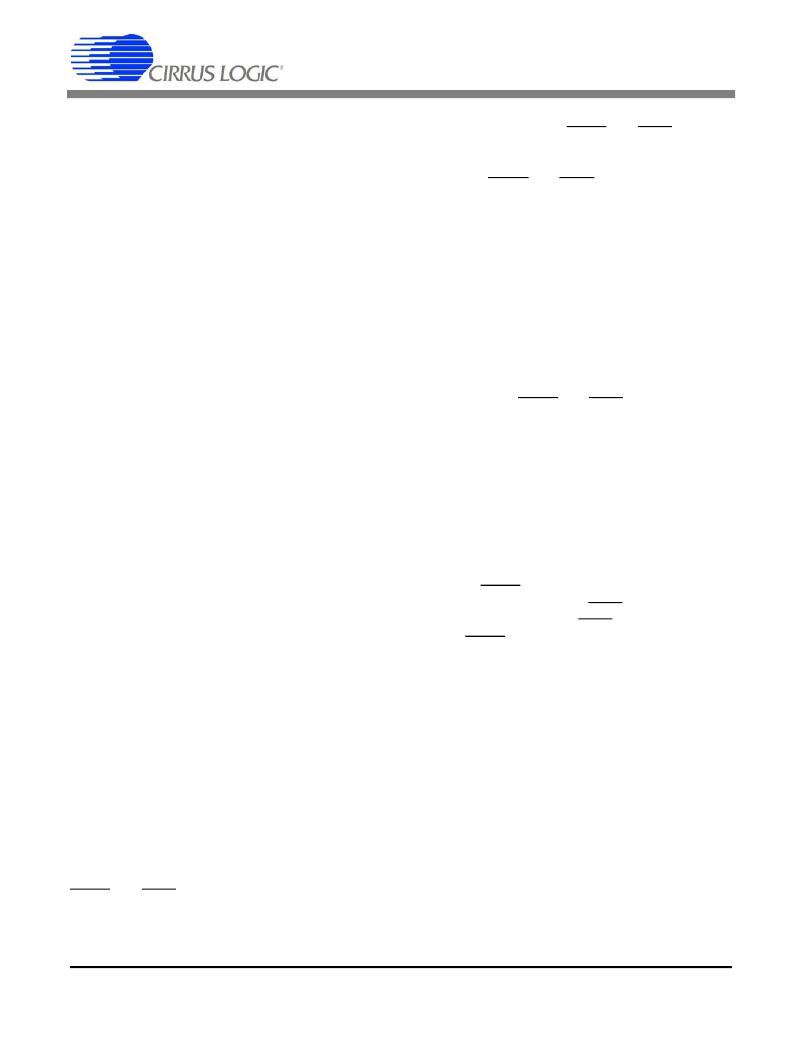- 您现在的位置:买卖IC网 > Sheet目录1201 > CDB5460AU (Cirrus Logic Inc)EVALUATION BOARD FOR CS5460A
�� �
�
 �
�CS5460A�
�PR� =� 500� ------------------� ?� --------------� ?� ------------------� ?� ------------------� ?� ------------------�
�kW� ?� hr� 3600s� 1000W�
�Ign� or� Vgn� =� -------------� ?� 1.00441� =� 0x404830�
�EXAMPLE� #2:� The� required� number� of� pulses� per�
�unit� energy� present� at� EOUT� is� specified� to� be�
�500� pulses/kW-hr;� given� that� the� maximum�
�line-voltage� is� 250� V� (RMS)� and� the� maximum�
�line-current� is� 20� A� (RMS).� In� such� a� situation,� the�
�nominal� line� voltage� and� current� do� not� determine�
�the� appropriate� pulse-rate� setting.� Instead,� the�
�maximum� line� levels� must� be� considered.� As� be-�
�fore,� the� given� maximum� line-voltage� and� line-cur-�
�rent� levels� are� used� to� determine� K� V� and� K� I� :�
�K� V� =� 150� mV� /� 250� V� =� 0.0006�
�K� I� =� 150� mV� /� 20� A� =� 0.0075� ?�
�Again� the� sensor� gains� are� calculated� such� that� the�
�maximum� line-voltage� and� line-current� levels� will�
�measure� as� 0.6� in� the� RMS� Voltage� Register� and�
�RMS� Current� Register.�
�The� required� Pulse-Rate� Register� setting� is� now�
�determined� by� using� the� following� equation:�
�pulses� 1hr� 1kW� 250mV� 250mV�
�K� V� K� I�
�Therefore� PR� =� ~1.929� Hz.�
�Note� that� the� Pulse-Rate� Register� cannot� be� set� to�
�a� frequency� of� exactly� 1.929� Hz.� The� closest� set-�
�ting� that� the� Pulse-Rate� Register� can� obtain� is�
�0x00003E� =� 1.9375� Hz.� To� improve� the� accuracy,�
�either� gain� register� can� be� programmed� to� correct�
�for� the� round-off� error� in� PR.� This� value� would� be�
�calculated� as�
�PR�
�1.929�
�In� the� last� example,� suppose� a� value� for� MCLK/K�
�of� 3.05856� MHz.� When� MCLK/K� is� not� equal� to�
�4.096� MHz,� the� result� for� ‘PR’� that� is� calculated� for�
�the� Pulse-Rate� Register� must� be� scaled� by� a� cor-�
�rection� factor� of:� 4.096� MHz� /� (MCLK/K).� In� this�
�case� the� result� is� scaled� by� 4.096/3.05856� to� get� a�
�final� PR� result� of� ~2.583� Hz.�
�3.2� Pulse� Output� for� Normal� Format,�
�Stepper� Motor� Format� and� Mechanical�
�Counter� Format�
�The� duration� and� shape� of� the� pulse� outputs� at� the�
�EOUT� and� EDIR� pins� can� be� set� for� three� different�
�output� formats.� The� default� setting� is� for� Normal�
�output� pulse� format.� When� the� pulse� is� set� to� either�
�22�
�of� the� other� two� formats,� the� time� duration� and/or�
�the� relative� timing� of� the� EOUT� and� EDIR� pulses� is�
�increased/varied� such� that� the� pulses� can� drive� ei-�
�ther� an� electro-mechanical� counter� or� a� stepper�
�motor.� The� EOUT� and� EDIR� output� pins� are� capa-�
�ble� of� driving� certain� low-voltage/low-power� coun-�
�ters/stepper� motors� directly.� This� depends� on� the�
�drive� current� and� voltage� level� requirements� of� the�
�counter/motor.� The� ability� to� set� the� pulse� output�
�format� to� one� of� the� three� available� formats� is� con-�
�trolled� by� setting� certain� bits� in� the� Control� Regis-�
�ter.�
�3.2.1� Normal� Format�
�Referring� to� the� description� of� the� Control� Register�
�in� Section� 5.,� Register� Descriptions� ,� if� both� the�
�MECH� and� STEP� bits� are� set� to� ‘0’,� the� pulse� out-�
�put� format� at� the� EOUT� and� EDIR� pins� is� illustrated�
�in� Figure� 10.� These� are� active-low� pulses� with� very�
�short� duration.� The� pulse� duration� is� an� integer�
�multiple� of� MCLK� cycles,� approximately� equal� to�
�1/16� of� the� period� of� the� contents� of� the� Pulse-Rate�
�Register.� However� for� Pulse-Rate� Register� set-�
�tings� less� than� the� sampling� rate� (which� is�
�[MCLK/8]/1024),� the� pulse� duration� will� remain� at� a�
�constant� duration,� which� is� equal� to� the� duration� of�
�the� pulses� when� the� Pulse-Rate� Register� is� set� to�
�[MCLK/K]/1024.� The� maximum� pulse� frequency�
�from� the� EOUT� pin� is� therefore� [MCLK/K]/16.�
�When� energy� is� positive,� EDIR� is� always� high.�
�When� energy� is� negative,� EDIR� has� the� same� out-�
�put� as� EOUT.� When� MCLK/K� is� not� equal� to�
�4.096� MHz,� the� true� pulse-rate� can� be� found� by�
�first� calculating� what� the� pulse-rate� would� be� if� a�
�4.096� MHz� crystal� is� used� (with� K� =� 1)� and� then�
�scaling� the� result� by� a� factor� of�
�(MCLK/K)� /� 4.096� MHz.�
�When� set� to� run� in� Normal� pulse� output� format,� the�
�pulses� may� be� sent� out� in� “bursts”� depending� on�
�both� the� value� of� the� Pulse-Rate� Register� as� well�
�as� the� amount� of� billable� energy� that� was� regis-�
�tered� by� the� CS5460A� over� the� most� recent� A/D�
�sampling� period,� which� is� (in� Hz):� 1� /� [(MCLK/K)� /�
�1024].� A� running� total� of� the� energy� accumulation�
�is� maintained� in� an� internal� register� (not� accessible�
�to� the� user)� inside� the� CS5460A.� If� the� amount� of�
�energy� that� has� accumulated� in� this� register� over�
�the� most� recent� A/D� sampling� period� is� equal� to� or�
�greater� than� the� amount� of� energy� that� is� repre-�
�DS487F5�
�发布紧急采购,3分钟左右您将得到回复。
相关PDF资料
CDB5461AU
BOARD EVAL & SOFTWARE CS5461A
CDB5466U
BOARD EVAL & SOFTWARE CS5466 ADC
CDB5467U
BOARD EVAL FOR CS5467 ADC
CDB5560-2
DEV BOARD FOR CS5560 W/SE INPUT
CDB5571-2
DEV BOARD FOR CS5571 W/SE INPUT
CDB8422
BOARD EVAL FOR CS8422 RCVR
CDB8952T
BOARD EVAL FOR CS8952
CDCE906-706PERFEVM
EVAL MOD PERFORMANCE CDCE906/706
相关代理商/技术参数
CDB5460AU-Z
制造商:Cirrus Logic 功能描述:PB-FREEEVAL BOARD FOR CS5460 - Bulk
CDB5461
制造商:Cirrus Logic 功能描述:EVAL BD FOR CS5461 - Bulk
CDB5461A
功能描述:EVAL BOARD FOR CS5461 RoHS:否 类别:编程器,开发系统 >> 过时/停产零件编号 系列:- 标准包装:1 系列:- 类型:MCU 适用于相关产品:Freescale MC68HC908LJ/LK(80-QFP ZIF 插口) 所含物品:面板、缆线、软件、数据表和用户手册 其它名称:520-1035
CDB5461AU
功能描述:数据转换 IC 开发工具 Eval Bd Sngl-Phase Pow/Energy
RoHS:否 制造商:Texas Instruments 产品:Demonstration Kits 类型:ADC 工具用于评估:ADS130E08 接口类型:SPI 工作电源电压:- 6 V to + 6 V
CDB5461AU-Z
制造商:Cirrus Logic 功能描述:PB-FREEEVAL BOARD FOR CS5461 WITH USB - Bulk
CDB5462
制造商:Cirrus Logic 功能描述:EVAL BOARD FOR CS5462 - Bulk
CDB5463U
功能描述:数据转换 IC 开发工具 Eval Bd Sngl-Phase Pow/Energy
RoHS:否 制造商:Texas Instruments 产品:Demonstration Kits 类型:ADC 工具用于评估:ADS130E08 接口类型:SPI 工作电源电压:- 6 V to + 6 V
CDB5463U-Z
功能描述:EVAL BOARD USB FOR CS5463 RoHS:是 类别:编程器,开发系统 >> 评估板 - 模数转换器 (ADC) 系列:- 产品培训模块:Obsolescence Mitigation Program 标准包装:1 系列:- ADC 的数量:1 位数:12 采样率(每秒):94.4k 数据接口:USB 输入范围:±VREF/2 在以下条件下的电源(标准):- 工作温度:-40°C ~ 85°C 已用 IC / 零件:MAX11645 已供物品:板,软件